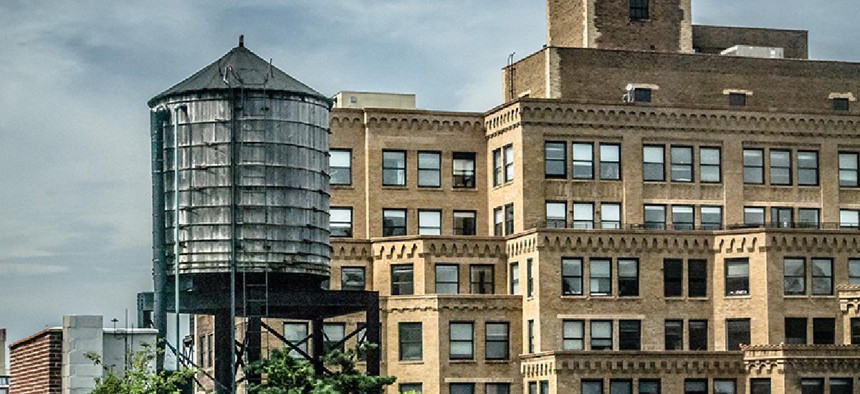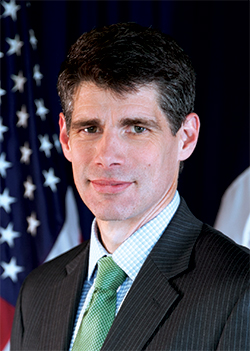The water supply

T.Slack / Shutterstock
Although turning on a tap may seem easy, there is a long process to get water from upstate reservoirs to a New York City sink. Paul Rush, deputy commissioner for the Bureau of Water Supply in the New York City Department of Environmental Protection, oversees the operation and maintenance of New York City’s 19 reservoirs and three controlled lakes, which store a total of 580 billion gallons of water. Nearly 1,000 employees who maintain infrastructure across the city’s 1.2 million-acre watershed, including 300 miles of aqueducts, 29 water supply dams, 57 bridges, 99 miles of road and seven upstate wastewater treatment facilities. In an interview with City & State, Rush discussed how his bureau maintains good water quality, the DEP’s reservoir infrastructure and the path drinking water takes from upstate to the five boroughs.
C&S: How does the New York City Department of Environmental Protection monitor the water supply to ensure that New Yorkers are getting clean water?
PR: New York City is fortunate to have some of the best drinking water in the United States, but that doesn’t happen by accident. DEP funds and administers a number of programs that aim to preserve the city’s high-quality water by protecting it as its source, in the watershed. We purchase and protect sensitive lands that include streams or steep slopes, pursue projects to improve the health of forests that surround our reservoirs and (the) streams that feed them, and we work with watershed communities to improve wastewater collection and treatment. These programs are funded by city water ratepayers, but they are carried out by a variety of nonprofit groups in the watershed who share our mission of protecting water quality. Our watershed protection programs are the envy of large cities throughout the world. In fact, this past year we hosted visitors from India, China, Colombia and other countries – all of whom were here to learn from New York City’s solutions to problems that they still struggle with. It’s also worth noting that the city also oversees regulations in the watershed to ensure that every project is built in a manner that is compatible with protecting water quality.
Our watershed programs and regulations are important, but it’s equally important to have a science-based way of measuring their effectiveness and the quality of New York City’s water. That’s why DEP operates four state-certified laboratories. Our scientists test New York City’s drinking water about 600,000 times a year for more than 250 parameters. That includes tests that are performed at nearly 1,000 street-side sampling stations in the five boroughs, which tell us the quality of the water in every neighborhood. Recently, we have expanded our water quality program to include a robotic monitoring system. This system comprises buoys on our reservoirs that send water quality data back to our operators in real time, telling them about the quality of water as it moves across the reservoirs and toward their intakes. This allows us to make well-informed operational decisions and always send the highest quality water from our 22 reservoirs to the city.
RELATED: An interview with acting DEP Commissioner Vincent Sapienza
 C&S: What does the DEP have planned to commemorate the anniversaries of the water systems? How are the systems holding up after more than 100 years?
C&S: What does the DEP have planned to commemorate the anniversaries of the water systems? How are the systems holding up after more than 100 years?
PR: DEP makes it a point to mention these landmarks in practically every public talk that we give, whether it’s with community groups, or school teachers or others who are interested in our water supply. The system is in very good shape, but once again the infrastructure doesn’t stay sound by accident.
We have a number of large improvement projects that are happening now, and several that are planned for the near future. We’re working on a $1 billion project to repair the Delaware Aqueduct, a $150 million effort to clean and refurbish our Catskill Aqueduct and we’re finishing up a $400 million program to upgrade Gilboa Dam at Schoharie Reservoir as well as some of its intake structures.
We operate the largest municipal water supply in America, and keeping it in a state of good repair requires regular investment. That’s why we recently announced a $750 million program to upgrade the dam, dikes and intake structures at Ashokan Reservoir, the city’s first reservoir in the Catskills. And it’s why we’ll be pursuing a number of other projects to ensure our infrastructure is strong for the next generation of New Yorkers.
C&S: Could you speak a little about the tunnel boring project to repair the Delaware Aqueduct – what will that entail?
PR: The 85-mile Delaware Aqueduct is the longest tunnel in the world. Back in the early 1990s, we discovered that it was leaking in two locations – one in Ulster County, and another on the west bank of the Hudson River in Orange County. The leak in Orange County, in Newburgh, is by far the largest. Because about 50 percent of New York City’s drinking water is delivered by the Delaware Aqueduct, it took us a while to figure out a repair that we could deliver while also making sure the city had an ample, reliable supply of water. When we found the problem in 1990, daily water consumption was about 1.5 billion gallons. Even though the city has grown by about 1.5 million people since then, water use had dropped by more than 30 percent, to about 1 billion gallons per day. This is one of the factors that allowed us to go ahead with a repair.
The $1 billion repair project is the largest and most complex repair project in the history of the city’s water supply. It involves building a 2.5-mile bypass tunnel 600 feet under the Hudson River, from Orange (County) to Dutchess County. The bypass tunnel will be connected to structurally sound portions of the existing aqueduct to convey water around the leaking section. The leaking stretch will be plugged and taken out of service forever. To connect the bypass, the Delaware Aqueduct will be shut down for 6-8 months in the year 2022. During that time, workers will also enter the aqueduct in Ulster County to grout closed the smaller leaks. New York City will rely on the Catskill and Croton water supply systems to deliver all its water during that shutdown.
This project has taken a lot of preparation and planning, but we are confident we can accomplish the largest repair ever without New Yorkers even noticing.
C&S: How is water transported to New York City from the reservoirs?
PR: Water is conveyed to the city through a network of aqueducts. The city has three distinct supply systems that work in concert with each other – Croton, Catskill and Delaware. The Croton system, which was put online in 1842, delivers water through the New Croton Aqueduct, running from Croton Reservoir in Westchester County all the way into Manhattan. The Catskill system delivers its water through the unique Catskill Aqueduct, which snakes its way through the natural contours of the valleys to deliver water to the city by gravity alone. The 85-mile Delaware Aqueduct, the longest tunnel in the world, delivers water to the city from our Delaware system. It is a deep rock tunnel that was drilled and blasted in the 1940s. Within the five boroughs, the water travels through three large tunnels – City Water Tunnels No. 1, No. 2 and No. 3 – that are then connected to 7,000 miles of water mains that deliver the water to homes and businesses.
RELATED: How much longer can politicians ignore climate change?
C&S: What are the biggest challenges to providing a clean water supply?
PR: We are in a no-fail business. It’s pretty amazing when you think about it. Since the Croton system was turned on in 1842, the city has gone 175 years without a major disruption to water service. We have to protect public health and the economic vitality of New York City by keeping that water flowing 24 hours a day, every day of every year. No exceptions.
But that water flows through infrastructure that nobody sees. With the exception of our dams and reservoirs, all the aqueducts, the pipes, the treatment facilities are largely out of the public’s view. So a big challenge is making sure the public understands the need to keep these facilities in a state of good repair. While they are out of sight, they cannot be out of mind. The city’s water supply is considered a marvel of modern engineering. When the city began construction of Ashokan Reservoir, the mayor at the time compared it to the great works of Rome, Egypt and Babylon, noting that this water supply was going to be New York City’s contribution to the great public works of the history of the world. There was a certain timescale built into that speech – an expectation that the supply would “last for the ages.”
While the water supply will be around for centuries, DEP employees are only here for a relatively short time. We are the stewards of this system for 20, 30, maybe 40 years. And it’s our duty to make sure that we leave it as good or better than it was when we first arrived.